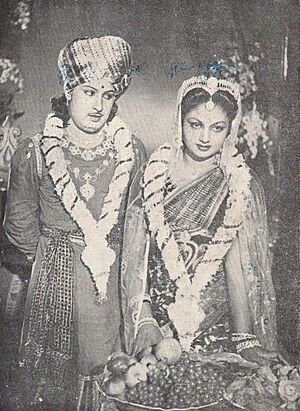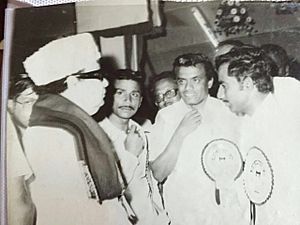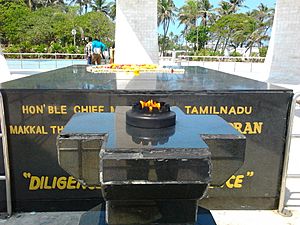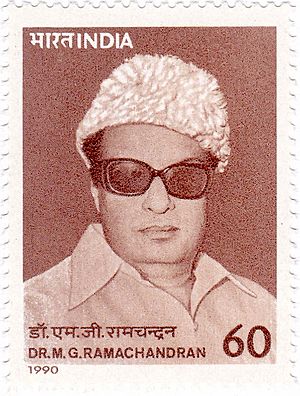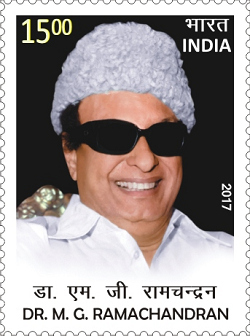M. G. Ramachandran facts for kids
Quick facts for kids
M. G. Ramachandran
|
|
|---|---|
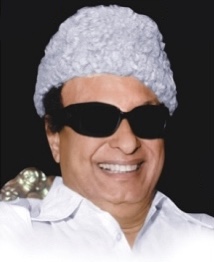
Portrait from 2017 Stamp
|
|
| 3rd Chief Minister of Tamil Nadu | |
| In office 9 June 1980 – 24 December 1987 |
|
| Governor |
|
| Preceded by | President's rule |
| Succeeded by | V. N. Janaki Ramachandran |
| Constituency | Madurai West (1980-1985) Andipatti (1985-1987) |
| In office 30 June 1977 – 17 February 1980 |
|
| Governor | Prabhudas Patwari |
| Preceded by | President's rule |
| Succeeded by | President's rule |
| Constituency | Aruppukottai |
| Member of the Tamil Nadu Legislative Assembly | |
| In office 24 December 1984 – 24 December 1987 |
|
| Chief Minister | Himself |
| Political Party | AIADMK |
| Preceded by | S. S. Rajendran |
| Succeeded by | P. Aasiyan |
| Constituency | Andipatti |
| In office 9 June 1980 – 15 November 1984 |
|
| Chief Minister | Himself |
| Political Party | AIADMK |
| Preceded by | T. P. M. Periyaswamy |
| Succeeded by | Pon. Muthuramalingam |
| Constituency | Madurai West |
| In office 30 June 1977 – 17 February 1980 |
|
| Chief Minister | Himself |
| Political Party | AIADMK |
| Preceded by | Sowdi Sundara Bharathi |
| Succeeded by | M. Pitchai |
| Constituency | Aruppukottai |
| In office 1 March 1967 – 31 January 1976 |
|
| Chief Minister | |
| Political Party | |
| Preceded by | position established |
| Succeeded by | position abolished |
| Constituency | St. Thomas Mount |
| Member of the Madras State Legislative Council | |
| In office 30 March 1962 – 7 July 1964 |
|
| Chief Minister |
|
| Succeeded by | S.R.P. Ponnuswamy Chettiar |
| 1st General Secretary of the All India Anna Dravida Munnetra Kazhagam | |
| In office 17 October 1986 – 24 December 1987 |
|
| Preceded by | S. Raghavanandam |
| Succeeded by | V. R. Nedunchezhiyan |
| In office 17 October 1974 – 22 June 1978 |
|
| Preceded by | position established |
| Succeeded by | V. R. Nedunchezhiyan |
| Treasurer of the Dravida Munnetra Kazhagam | |
| In office 1969–1972 |
|
| Party President | M. Karunanidhi |
| General Secretary | V. R. Nedunchezhiyan |
| Preceded by | M. Karunanidhi |
| Succeeded by | K. Anbazhagan |
| President of the South Indian Artistes' Association | |
| In office 1961–1963 |
|
| Preceded by | R. Nagendra Rao |
| Succeeded by | S. S. Rajendran |
| In office 1957–1959 |
|
| Preceded by | N. S. Krishnan |
| Succeeded by | Anjali Devi |
| Personal details | |
| Born |
Maruthur Gopalan Ramachandran
17 January 1917 Nawalapitiya, Kandy District, British Ceylon (present-day Sri Lanka) |
| Died | 24 December 1987 (aged 70) Madras, Tamil Nadu, India (present-day Chennai) |
| Cause of death | Heart failure |
| Resting place | Puratchi Thalaivar M.G.R. Memorial |
| Nationality | Indian |
| Political party | |
| Other political affiliations |
|
| Spouse |
|
| Relatives | M. G. Chakrapani (brother) |
| Residences | M.G.R. Thottam, Ramapuram, Chennai, Tamil Nadu |
| Profession | |
| Awards |
|
| Nicknames |
|
| En rathathin rathamaana anbu udan pirappukkale ("Blood of my blood lovely siblings") |
|
Maruthur Gopalan Ramachandran (born 17 January 1917 – died 24 December 1987), known to many as M.G.R., was a famous Indian politician, actor, and filmmaker. He served as the Chief Minister of Tamil Nadu from 1977 until his death in 1987. M.G.R. founded the AIADMK political party. After he passed away, he was given India's highest civilian award, the Bharat Ratna, in 1988.
Contents
Early Life and Beginnings
M.G.R. was born in Kandy, which is now part of Sri Lanka, on 17 January 1917. His family was from Kerala, India. When M.G.R. was very young, his father passed away. His mother worked hard to raise him and his older brother, M. G. Chakrapani.
To help his family, M.G.R. and his brother joined a drama group. This is where he started his acting journey. He learned singing, dancing, and sword fighting. These early challenges helped shape him into the person he became.
M.G.R. was a religious person in his youth. Later, when he joined the DMK political party, he became more focused on logic and reason.
M.G.R. was married three times. His third wife was V. N. Janaki, a former actress. She later became a chief minister of Tamil Nadu herself. M.G.R. did not have any children.
Becoming a Film Star
M.G.R. started his film career in 1936 with the movie Sathi Leelavathi. He often starred in romantic or action films. He became very popular after his 1950 film, which was written by M. Karunanidhi. His fame grew even more with the 1954 film Malaikkallan.
He was the hero in Tamil cinema's first full-length color film, Alibabavum 40 Thirudargalum (1955). M.G.R. won the National Film Award for Best Actor for his role in the film Rickshawkaran in 1972.
His 1973 movie Ulagam Sutrum Valiban was a huge success. It was filmed in many different countries like Singapore, Malaysia, and Japan. M.G.R.'s acting career continued until 1987. His last film was Ullagam Suthi Paru. He believed that actors should never truly 'retire'.
Who Mentored M.G.R. in Acting?
Two important people guided M.G.R. in his acting journey. They were Kali N. Rathnam, a famous Tamil stage drama pioneer, and K.P. Kesavan.
Journey into Politics
M.G.R. was first a member of the Congress Party until 1953. In 1953, he joined the Dravida Munnetra Kazhagam (DMK) party, led by C. N. Annadurai. He was drawn to their ideas about Tamil culture and progress.
His popularity as a film star helped him gain many supporters in politics. He became a member of the state's Legislative Council in 1962. In 1967, at age 50, he was elected to the Tamil Nadu Legislative Assembly. After Annadurai's death, M.G.R. became the treasurer of the DMK in 1969.
Forming His Own Party: AIADMK
In 1972, M.G.R. had disagreements with the DMK leader, M. Karunanidhi. M.G.R. felt that corruption was growing in the party. Because of these differences, he was asked to leave the DMK.
After leaving, M.G.R. started his own political party. It was first called Anna Dravida Munnetra Kazhagam. Later, it was renamed the All India Anna Dravida Munnetra Kazhagam (AIADMK). This new party quickly became a strong opponent to the DMK. M.G.R. used his films to share his party's goals with the public.
Winning Elections in Tamil Nadu
1977 Assembly Elections
The AIADMK took part in the 1977 Tamil Nadu Legislative Assembly election. M.G.R.'s party formed alliances with other groups. The AIADMK alliance won a big victory, securing 144 out of 234 seats.
On 30 June 1977, M.G.R. became the Chief Minister of Tamil Nadu. He was the first popular film actor in India to become a Chief Minister. He stayed in office until his death in 1987. The AIADMK won every state election while M.G.R. was alive.
1980 Elections: A Comeback
In 1980, the central government dismissed M.G.R.'s government. This meant new elections were held in Tamil Nadu. Even though the DMK and Congress party had won the national elections, M.G.R. and the AIADMK won the state election again. M.G.R. was sworn in as Chief Minister for the second time.
1984 Assembly Elections: Winning from Hospital
In October 1984, M.G.R. became very ill with kidney problems. He was treated in a hospital in New York City. At the same time, national elections were happening.
Even from his hospital bed, M.G.R. ran for election. Videos of him recovering in the hospital were shown across Tamil Nadu. This created a lot of sympathy among the people. The AIADMK, allied with the Congress party, won a huge victory. This showed how much people still loved and supported M.G.R.
Helping Others (Philanthropy)
M.G.R. was known for his kindness and generosity. He often provided help during disasters like floods and droughts. He was the first person to donate a large sum of money (Rs. 75,000) to the war fund during the 1962 war with China.
He also started a weekly magazine called Thai and a daily newspaper called Anna. M.G.R. owned Sathya Studios and Emgeeyar Pictures, which produced many of his films. He left these to charity in his will.
Illness and Passing Away
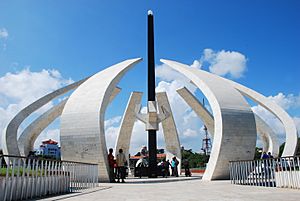
In October 1984, M.G.R. became very sick with kidney failure. He also had a mild heart attack and a stroke. He went to the United States for treatment and had a kidney transplant. Even though he was unwell, he won the election that year.
M.G.R. returned to India in February 1985 and became Chief Minister for the third time. He continued to travel for medical treatment.
M.G.R. passed away on 24 December 1987, at his home in Chennai. He was 70 years old. His death caused a lot of sadness and public mourning across Tamil Nadu. Many people came to pay their respects.
His body was placed at Rajaji Hall for two days so the public could say goodbye. On 25 December 1987, he was buried at Marina beach in Chennai. This place is now called the MGR Memorial.
After his death, his political party, the AIADMK, faced some challenges. Later, his wife V. N. Janaki Ramachandran and J. Jayalalithaa worked together to unite the party.
M.G.R. also left his home to charity. It is now the Dr. M. G. R. Home and Higher Secondary School for the Speech and Hearing Impaired. His film studio, Sathya Studios, became a women's college.
M.G.R.'s Lasting Impact
M.G.R. is still remembered as a very important leader in Tamil Nadu. He is often called "Puratchi Thalaivar," which means "Revolutionary Leader."
Many places in Tamil Nadu are named after him to honor his memory:
- A major road in Chennai is called Dr. M.G.R. Salai.
- A neighborhood in Chennai is named M.G.R. Nagar.
- The Central Bus Stand in Salem is now Bharat Ratna Dr. M.G.R. Central Bus Stand.
- The New Bus Stand in Tirunelveli is called Bharat Ratna Dr. M.G.R. Bus Stand.
- Parks in Thoothukudi are named after him.
- In 2006, a life-size statue of M.G.R. was placed in the Parliament House in Delhi.
- In 2017, the Indian government released special coins to celebrate his 100th birthday.
- The Mattuthavani Bus Stand in Madurai was renamed M.G.R. Bus Stand in 2017.
- The Chennai Mofussil Bus Terminus was renamed Puratchi Thalaivar Dr. M.G.R. Bus Terminus in 2018.
- Chennai Central Railway Station was renamed Puratchi Thalaivar Dr. M.G. Ramachandran Central Railway Station in 2019.
- The Central Metro station in Chennai was renamed Puratchi Thalaivar Dr. M.G. Ramachandran Central Metro in 2020.
- The AIADMK headquarters in Chennai was renamed Puratchi Thalaivar M.G.R. Maaligai in 2021.
Awards and Recognitions
M.G.R. received many awards for his work in films and for his public service.
Honors
| Year | Award | Reason |
|---|---|---|
| 1974 | Honorary doctorate | For his contributions to Indian Cinema |
| 1987 | Honorary doctorate | For his contributions to Tamil Cinema |
| 1988 | Bharat Ratna | For his contributions to public service (given after his death) |
Other Cinema Awards
| Year | Award / Category | Film |
|---|---|---|
| 1965 | Filmfare Awards South - Special Jury award | Enga Veettu Pillai |
| 1968 | Tamil Nadu State Film Award for Best Actor | Kudiyirundha Koyil |
| 1969 | Tamil Nadu State Film Award for Best Film | Adimaippenn |
| 1969 | Filmfare Awards South - Best Film | Adimaippenn |
| 1971 | National Film Awards - Best Actor | Rickshawkaran |
Images for kids


